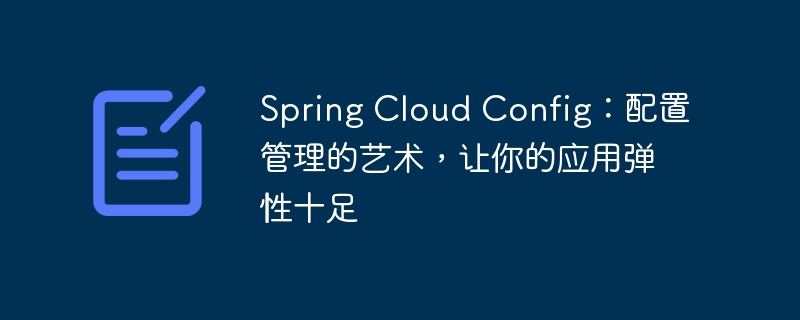

php editor Apple introduces to you Spring Cloud Config - an art of configuration management. Through Spring Cloud Config, you can achieve centralized management and dynamic refresh of configurations, making your applications more elastic and flexible. Whether it is a microservice architecture or a distributed system, Spring Cloud Config can provide you with powerful support to make your application more stable and efficient. Let us explore the charm of Spring Cloud Config, improve your application management level, and enjoy the fun of configuration management!
The configuration server is the core component of Spring Cloud Config. It is responsible for storing and managing configuration data and providing it to applications. To set up the configuration server, you need to create the following beans:
@SpringBootApplication
public class ConfigServerApplication {
public static void main(String[] args) {
SpringApplication.run(ConfigServerApplication.class, args);
}
}To configure the configuration server, you need to specify the path to the configuration file:
spring.cloud.config.server.native.searchLocations=file:./config
Client configuration applications use the configuration server to obtain their configuration. To configure the client application, you need to add the following dependencies:
<dependency> <groupId>org.springframework.cloud</groupId> <artifactId>spring-cloud-starter-config</artifactId> </dependency>
Then you need to create the following beans:
@SpringBootApplication
public class ConfiGClientApplication {
public static void main(String[] args) {
SpringApplication.run(ConfigClientApplication.class, args);
}
}To obtain configuration from the configuration server, you need to specify the URL of the configuration server:
spring.cloud.config.uri=Http://localhost:8888
Configuration data is stored in the repository. You can use various repositories to store configuration data, such as git, SVN, Eureka, etc. To configure a repository, you need to specify the URL of the repository:
spring.cloud.config.server.git.uri=https://GitHub.com/user/repository
The configuration server allows you to dynamically refresh configuration data. To refresh the configuration, you call the @RefreshScope annotated bean in your client application.
@RefreshScope
@RestController
public class ConfigController {
@Value("${my.property}")
private String property;
@GetMapping("/")
public String get() {
return property;
}
}Using Spring Cloud Config has the following advantages:
Spring Cloud Config is a powerful configuration management tool that helps you simplify the configuration of your application and achieve its elasticity and scalability. By using Spring Cloud Config, you can offload the burden of configuration management and focus on building great applications.
The above is the detailed content of Spring Cloud Config: The art of configuration management makes your application flexible. For more information, please follow other related articles on the PHP Chinese website!